Red light and near-infrared therapy can markedly boost your male fertility and testosterone production through a process called photobiomodulation. When you use specific wavelengths (660 nm and 850 nm), the light stimulates your cellular function, enhancing ATP production in testicular cells responsible for testosterone and sperm production. You'll find this non-invasive treatment can improve sperm count, motility, and quality while potentially doubling or tripling baseline testosterone levels. Studies show the therapy works by optimizing mitochondrial function and increasing blood flow to reproductive tissues. Understanding the science behind these impressive results reveals even more powerful benefits for male reproductive health.
Understanding Red Light Male Therapy
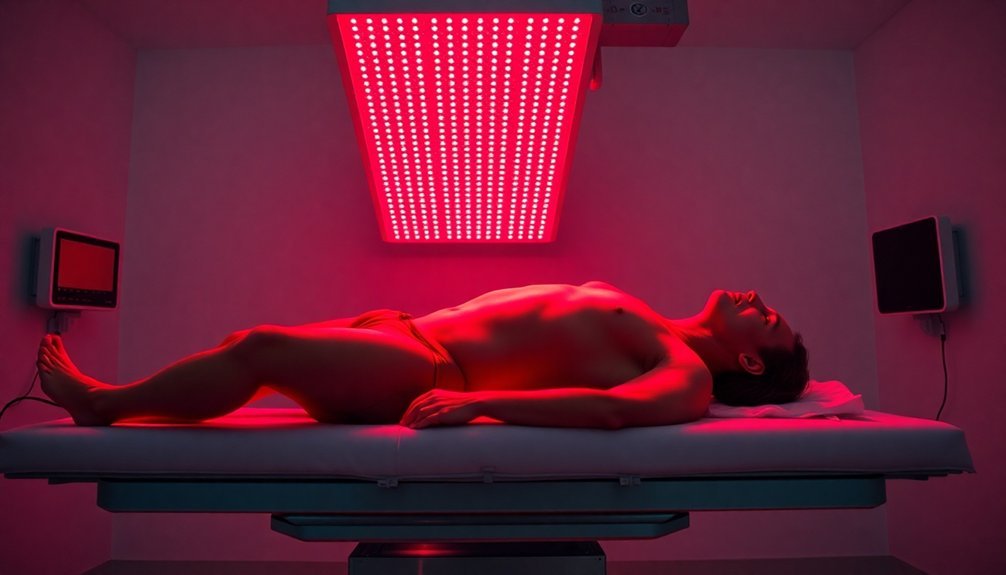
Through recent scientific advances, red light male therapy has emerged as a promising natural treatment for improving fertility and testosterone production in men. This innovative therapy works by targeting specific wavelengths of red light between 620nm and 670nm, which penetrate the tissue and stimulate cellular function in the testes.
You'll find that red light therapy's effectiveness stems from its interaction with your body at the cellular level. The light stimulates photoreceptor proteins in your testes, enhancing ATP production in Leydig cells – the cells responsible for testosterone production.
This process, known as photobiomodulation, directly affects your body's electron transport chain, boosting mitochondrial function and energy production. The therapy has shown particular promise for men over 30, as testosterone naturally declines by 1-2% annually after this age.
When you're exposed to red light therapy, your body responds by naturally increasing testosterone levels. Studies have shown remarkable results, with some men experiencing up to double or triple their baseline testosterone levels.
The treatment mimics your body's natural seasonal hormone fluctuations and can show positive results in as little as two weeks with daily 30-minute sessions. It's a non-invasive, FDA-cleared approach that doesn't require medication or surgical intervention.
Benefits for Sperm Production
With groundbreaking advancements in fertility treatments, infrared light therapy has proven remarkably effective at enhancing sperm production and quality. You'll find that this non-invasive treatment directly targets the cellular mechanisms responsible for healthy sperm development, boosting both motility and viability within just one hour of application.
When you undergo infrared light therapy, the treatment works by increasing energy production in your sperm cells' mitochondria, which is essential for tail movement and overall sperm health. Research shows that excessive ROS levels can damage sperm cells and reduce fertility outcomes.
The deep-penetrating near-infrared light also reduces inflammation and improves blood flow to your reproductive tissues, creating a favorable environment for sperm production.
You can receive therapeutic laser treatments directly over your testes for just a few minutes, experiencing almost immediate improvements in sperm quality. The therapy's ability to raise ATP levels and increase oxygenated blood flow helps rejuvenate your reproductive tissues at a cellular level.
What's particularly beneficial is that you can tailor the treatment to your specific needs, and since it's pain-free, you won't experience any discomfort during the sessions.
Clinical studies support these benefits, showing significant improvements in sperm parameters following red and near-infrared light therapy.
Testosterone Enhancement Through Light
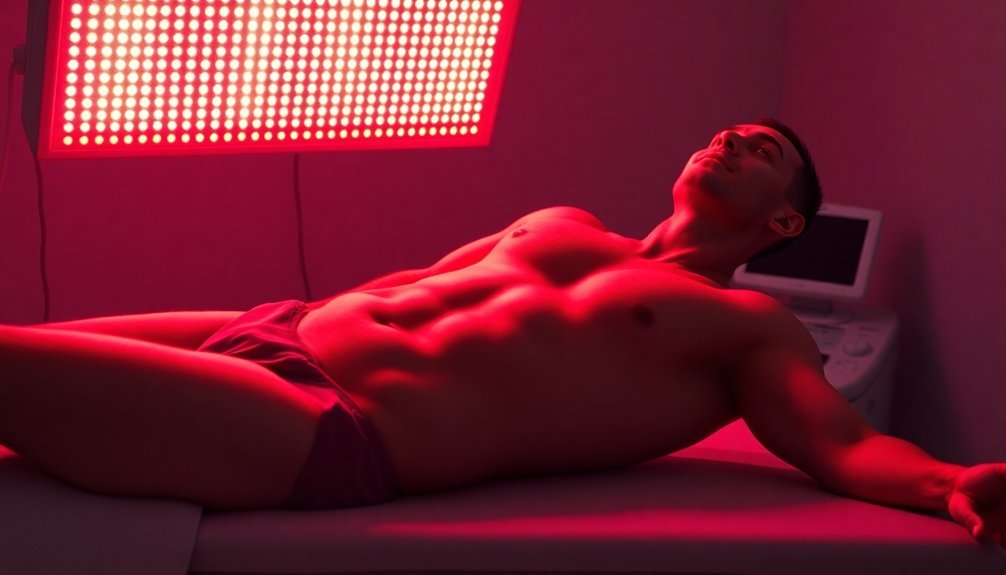
Beyond improving sperm quality, infrared light therapy offers another significant benefit: testosterone enhancement. When you receive light therapy treatment, particularly with bright or infrared light, it triggers several mechanisms that boost your testosterone production naturally.
The treatment works by inhibiting your pineal gland activity while stimulating the Leydig cells in your testes. These cells are responsible for testosterone production, and they respond positively to red and near-infrared wavelengths. Treatment sessions typically require sitting about three feet from the device for optimal results.
You'll also benefit from improved ATP production in your cells, which supports overall hormone production.
Clinical studies back these effects with impressive results. You can expect significant increases in testosterone levels – from 2.3 to 3.6 nanograms per milliliter in some cases.
What's more, you'll likely experience improved sexual satisfaction, with scores typically jumping from 2 to 6.3 out of 10.
The treatment mimics nature's seasonal effects on testosterone, which typically peaks in October and decreases between November and April.
Since it's non-pharmacological, you're getting a natural approach to hormone enhancement that's supported by multiple research studies showing consistent improvements in both testosterone levels and sexual satisfaction.
Mitochondrial Effects on Male Fertility
Your sperm's mitochondria act as cellular power plants, producing the essential ATP energy needed for strong motility and successful fertilization.
When you optimize your mitochondrial health through infrared treatment, you're enhancing your sperm cells' ability to produce energy efficiently and maintain proper function.
The boost in cellular energy production directly impacts your sperm's swimming capability and overall fertility potential, making mitochondrial function a key target for fertility enhancement. Oxidative stress levels can significantly affect sperm quality and motility, as excess reactive oxygen species damage mitochondrial function.
Energy Production Drives Motility
Sperm cells rely heavily on their powerhouse organelles – mitochondria – to generate the energy needed for successful fertilization. Through various metabolic pathways, your sperm cells can utilize different energy substrates like glucose, lactate, and pyruvate to produce the ATP required for movement and function.
This energy production system is remarkably adaptable, allowing sperm to maintain motility even in changing environments.
Your sperm's energy production directly impacts fertility through these critical processes:
- ATP generation powers the phosphorylation of proteins essential for hyperactivation – the vigorous swimming pattern needed to reach and penetrate the egg
- Mitochondrial content in the sperm's midpiece determines how much energy can be produced, with higher amounts leading to better progressive motility
- The balance between glycolysis and oxidative phosphorylation guarantees continuous energy supply, even if one pathway is compromised
When your mitochondria function properly, they maintain the high energy demands of sperm cells while controlling ROS production. However, factors like obesity or poor diet can disrupt this delicate balance, leading to decreased motility and reduced fertility potential.
Mitochondrial Health Boosts Fertility
Maintaining healthy mitochondria directly influences fertility outcomes by regulating multiple aspects of sperm function. Your sperm's mitochondria serve as powerhouses that control energy production, calcium balance, and oxidative stress levels – all vital elements for successful fertilization. When mitochondrial function declines, you'll experience reduced sperm motility and compromised fertility potential.
| Mitochondrial Factor | Impact on Fertility |
|---|---|
| Energy Production | Powers sperm movement and capacitation |
| DNA Integrity | Determines sperm quality and viability |
| ROS Management | Controls oxidative damage and stress |
You'll find that your lifestyle choices profoundly affect mitochondrial health. Smoking, excessive alcohol consumption, and aging can damage mitochondrial DNA and impair sperm function. However, you can protect your mitochondria through targeted interventions. Antioxidant supplements help neutralize harmful ROS, while maintaining a healthy lifestyle supports peak mitochondrial performance. By focusing on mitochondrial health, you're addressing a fundamental aspect of male fertility. Research shows that improving mitochondrial function enhances sperm motility, increases fertilization rates, and boosts overall reproductive success.
Cell Function Optimization Process
Throughout the cellular enhancement process, mitochondrial function plays a pivotal role in enhancing male fertility outcomes. When your cells work efficiently, they're better equipped to produce healthy sperm with proper motility and function.
Your mitochondria serve as cellular powerhouses, generating the essential energy needed for sperm movement and successful fertilization.
The enhancement process relies heavily on maintaining proper mitochondrial health through natural processes like autophagy, which removes damaged cellular components. You'll find that healthy mitochondria directly impact your fertility through:
- Enhanced ATP production, which powers sperm movement and increases overall motility for better fertilization chances
- Improved calcium homeostasis and regulated cell death processes, ensuring only the healthiest sperm cells survive
- Balanced reactive oxygen species (ROS) production, protecting sperm DNA from damage
Your body's cellular enhancement depends on proper mitochondrial dynamics and function. When these processes work correctly, you'll experience better sperm quality, improved motility, and enhanced fertility potential.
The absence of proper mitochondrial function can lead to reduced sperm quality and fertility challenges, making mitochondrial health essential for reproductive success.
Optimal Treatment Protocols
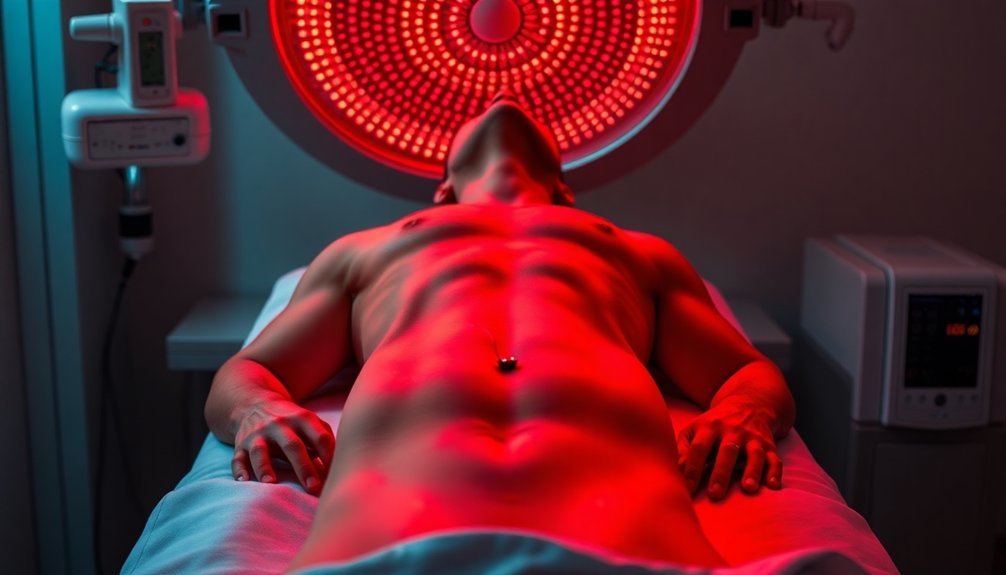
Establishing the right protocols for infrared fertility treatment requires careful attention to wavelength selection and dosage.
You'll want to focus on red light at 670nm, which research has proven most effective for male reproductive health, while near-infrared light at 830nm can serve as a complementary treatment option.
For best results, you'll need to apply 10 Joules per testicle when using near-infrared laser light at 808nm. You can expect significant improvements in sperm motility and viability within one hour when combining red and NIR light therapy.
While single sessions show immediate benefits, you'll achieve better outcomes with multiple treatments over several weeks.
The most successful approach involves three sessions per week, with direct application to the testicles being essential for effectiveness.
You'll need professional guidance to guarantee proper treatment protocols, as Class 3b and Class 4 laser equipment requires careful handling.
Your treatment plan should be tailored to your specific fertility issues, and you might see enhanced results when combining infrared therapy with other fertility treatments.
The science behind this approach is solid, with studies consistently showing improvements in sperm parameters and mitochondrial function.
Safety Measures During Treatment
You'll need to closely monitor temperature during infrared treatment sessions, keeping the exposure level between 37-38°C (98.6-100.4°F) to protect sperm production.
It's crucial to use proper protective equipment, including FDA-cleared devices with automatic shutoff features and temperature controls, while keeping the light source at least 6 inches away from the treatment area.
To prevent overheating, limit your treatment sessions to 10-15 minutes per area, with a maximum of two sessions per day and at least 6 hours between treatments.
Temperature Control Guidelines
When it comes to infrared treatment for male fertility, maintaining precise temperature control stands out as one of the most critical safety measures. Your testes need to stay between 32°C and 35°C for ideal sperm production, and any deviation from this range can impact your fertility.
Since even brief exposure to excessive heat can harm sperm health, you'll need to be vigilant during treatment sessions.
To maintain safe temperatures during your infrared therapy sessions, follow these essential guidelines:
- Monitor the treatment area's temperature continuously using the device's built-in sensors or external thermometers
- Limit your session duration according to your healthcare provider's instructions, typically stopping if you feel any uncomfortable warmth
- Guarantee proper ventilation in the treatment area and keep the device at the recommended distance from your body
You'll need to be particularly careful if you're sensitive to heat or have any underlying medical conditions. Don't hesitate to stop treatment immediately if you experience any discomfort.
Protective Equipment Requirements
The right protective equipment forms your first line of defense during infrared fertility treatments. When using LED light therapy devices, you'll need to guarantee proper protection while maintaining the best therapeutic benefits.
Start with FDA-cleared devices that are specifically designed for intimate areas, as these provide built-in safety features and appropriate light intensity levels.
You'll need to wear protective eyewear during treatments to shield your eyes from direct light exposure. If you're using medications, especially photosensitive drugs, you must consult your healthcare provider before starting treatment, as they may recommend additional protective measures.
Don't skip the protective gear even if you're using cold LED lights, as it's essential for maintaining treatment safety protocols.
Make sure your device includes proper spacing mechanisms to maintain the ideal distance between the light source and your skin. You should use protective covers or barriers provided with your device to guarantee hygienic treatment conditions.
If you're undergoing any other medical treatments, particularly cortisone or steroid injections, you'll need to discuss additional protective requirements with your healthcare provider. Remember, proper protection isn't just about safety equipment – it's also about following professional guidance and treatment protocols precisely.
Treatment Duration Limits
Properly timing your infrared treatments is essential for both safety and effectiveness. Research shows that even short exposure periods of one hour can lead to significant improvements in sperm health and motility. You don't need lengthy sessions to achieve benefits, as specific wavelengths of red and near-infrared light can enhance sperm viability within brief treatment windows.
When planning your treatment schedule, consider these key duration guidelines:
- Start with shorter sessions (15-30 minutes) to assess your body's response before gradually increasing duration.
- Avoid exceeding one hour per treatment session, as longer exposure hasn't shown additional benefits.
- Maintain consistency with your treatment schedule while allowing rest periods between sessions.
While ideal dosage protocols are still being researched, you'll find that red light therapy offers a safer alternative to traditional fertility treatments. It doesn't carry the risks associated with ionizing radiation or gonadotoxic therapies, and there's no evidence of long-term adverse effects.
You can confidently use this treatment to counteract negative environmental factors affecting your sperm health, such as heat exposure and environmental pollutants.
Clinical Research and Evidence
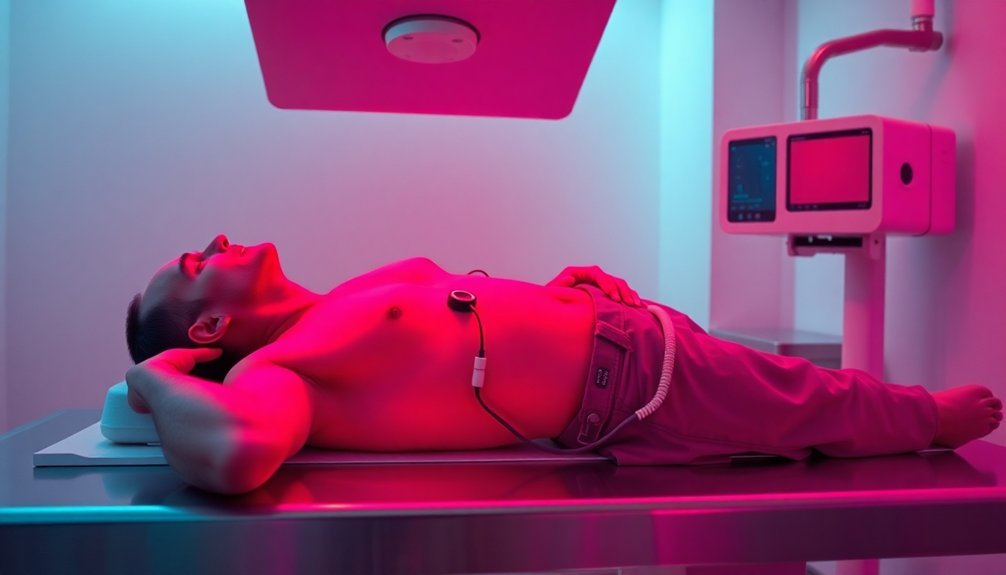
Recent clinical research has revealed promising evidence for infrared treatment's role in male fertility enhancement. Studies focusing on photobiomodulation (PBM) and low-level laser therapy have demonstrated substantial improvements in sperm quality and fertility outcomes.
Near-infrared light therapy, particularly using 830nm wavelengths, has shown remarkable success rates in clinical trials.
Research confirms that red and near-infrared light therapy works by enhancing cellular function through multiple mechanisms. It improves mitochondrial function in sperm cells, which is vital for tail motility and energy production. You'll see better sperm health outcomes because this treatment effectively reduces harmful ROS levels while boosting overall sperm viability.
The evidence is particularly compelling when you look at the thorough studies conducted. In one notable study, researchers found that specific protocols of red and near-infrared light notably improved sperm motility and viability in vitro.
These findings align with guidelines from both the American Urological Association and European Association of Urology, which emphasize the importance of thorough fertility evaluation and treatment approaches.
Home Treatment Best Practices
Building on these clinical findings, implementing effective home treatment practices can greatly enhance your fertility outcomes. You'll want to focus on using LED devices that emit red light at 670nm wavelength, as this specific range has shown the most promising results for improving sperm quality.
When setting up your treatment area, make certain you're using FDA-cleared devices and positioning them to maintain close skin contact without generating excess heat.
For the best results, follow these key guidelines:
- Schedule regular sessions three times per week, maintaining consistency in your treatment routine to achieve sustained improvements
- Keep sessions brief but effective, as studies show significant motility improvements can occur after just one treatment
- Position LED devices carefully to maximize light absorption while avoiding direct heat application to the testes
Remember that you shouldn't start any treatment program without first consulting your healthcare provider, especially if you're taking medications or have underlying health conditions.
It's vital to integrate these practices as part of a thorough fertility plan that includes proper medical evaluation and lifestyle modifications. Always use certified devices and follow manufacturer guidelines for maximum safety and effectiveness.
Light Therapy Device Selection
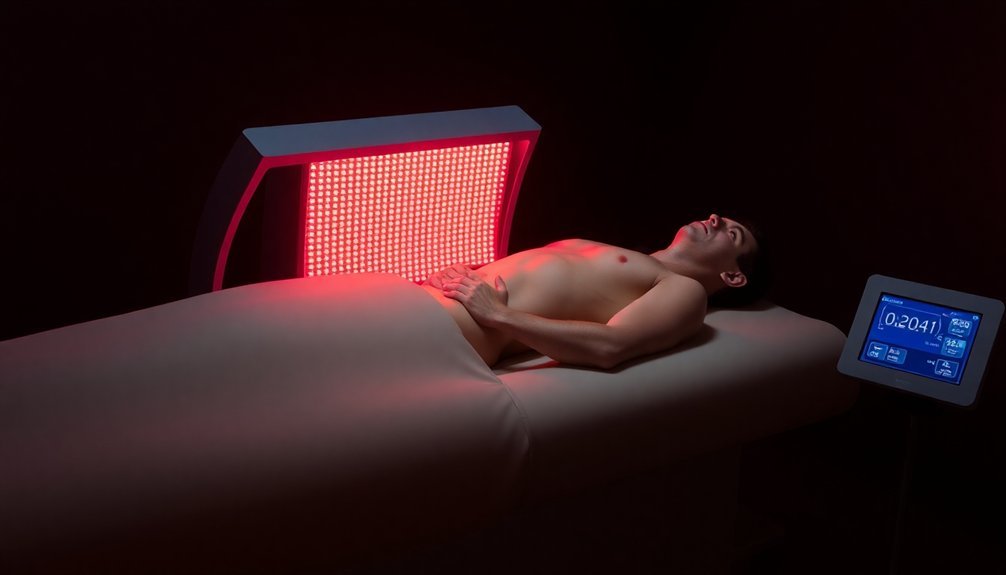
Selecting the right light therapy device stands as a crucial first step in your fertility treatment journey. When choosing a device, you'll want to focus on FDA-cleared options like Celluma that provide proven safety and effectiveness for male reproductive health.
| Feature | Why It Matters |
|---|---|
| Wavelength | Choose 620-670nm red light for ideal sperm health and motility |
| Heat Output | Select devices with minimal heat to protect testicular function |
| LED Type | Use LED-based devices for energy efficiency and safety |
| Certification | Look for FDA clearance and medical CE marking |
The device you select should emit red light specifically at 670nm, as this wavelength has shown the most promising results for male fertility enhancement. Don't opt for devices using near-infrared (830nm) wavelengths, as these are better suited for female fertility treatments.
Your chosen device should be able to contour close to the skin for maximum light absorption while remaining comfortable during use. Remember to check for contraindications, especially if you're taking photosensitive medications. The ideal device will provide consistent, even light distribution without generating excessive heat that could harm testicular tissue.
Frequently Asked Questions
Can Red Light Therapy Help With Varicocele-Related Infertility Issues?
Yes, red light therapy can help your varicocele-related fertility issues by improving sperm quality, reducing inflammation, and enhancing mitochondrial function. It's especially effective when combined with other treatments like varicocelectomy.
How Long Should Results From Red Light Therapy Last After Treatment Stops?
You'll typically experience red light therapy benefits for several weeks after stopping treatment. However, your results may vary based on individual factors, and you'll likely need ongoing sessions for sustained improvements.
Does Wearing Tight Underwear Affect the Effectiveness of Red Light Therapy?
Yes, tight underwear can reduce red light therapy's effectiveness by trapping heat around your testicles. You'll get better results wearing loose-fitting underwear since the ideal testicular temperature is vital for the therapy's benefits.
Can Red Light Therapy Be Combined With Fertility Medications Safely?
You shouldn't combine red light therapy with fertility medications without consulting your healthcare provider first. There's limited clinical evidence on their interaction, and safety concerns need professional evaluation before starting both treatments.
Will Red Light Therapy Affect Existing Sperm Stored in Sperm Banks?
You'll need to be cautious about applying red light therapy to stored sperm. While it can improve motility and viability in lab settings, it's not a standard procedure for sperm banks and requires specific protocols.
In Summary
You've discovered a promising treatment option for enhancing your male fertility and testosterone levels. Red and near-infrared light therapy won't just boost your sperm count and quality – it'll also support healthy hormone production through improved cellular function. Start with researched devices and proper protocols, and you'll maximize your results while maintaining safety. Remember to consult healthcare providers before beginning any new treatment regimen.





Leave a Reply